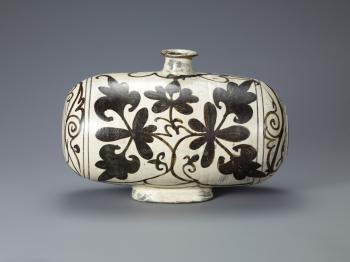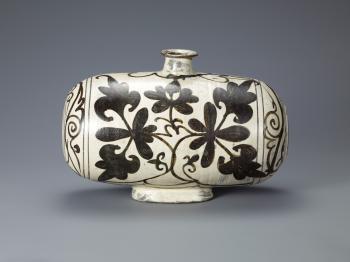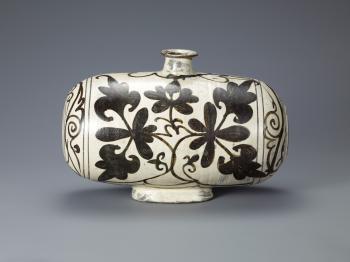NEW YORK—If you have a passion for poetry and Korean Buncheong ceramics, ‘tis time to head over to the Metropolitan Museum of Art to feast your eyes on some of these most exquisite Korean treasures.
Opening on Thursday, April 7, a special exhibition on loan from Leeum, Samsung Museum of Art (LSMA) in Seoul, Korea, “Poetry in Clay: Korean Buncheong Ceramics” will go on view at the Met.
“Poetry in Clay” is the brainchild and collaboration of Soyoung Lee, Met department of Asian Art assistant curator, and Seung-chang Jeon, LSMA’s chief curator.
“We are very pleased to be able to share Leeum, Samsung Museum of Art’s collection with an international audience. We wanted to show the imaginative designs and dynamism of buncheong ceramics, a uniquely Korean genre of art,” said Jeon.
This unique exhibition presents Korean buncheong ware, a bold, dynamic, and free-form ceramic tradition that flourished in Korea during the 15th and 16th centuries of the Joseon dynasty (1392–1910).
Derived from “bunjang hoecheong sagi,” the word “buncheong” was coined in the 20th century. It means gray-green stoneware decorated in white. The unique features of buncheong ware are its distinctive forms of decorative techniques and the use of white slip.
“Buncheong ware has been renowned for its playful simplicity and strikingly abstract designs,” said RaYoung Hong, LSMA deputy director.
While it is a rich embodiment of traditional Korean beauty, buncheong ware retains its strong element of modernity and the dynamism of Korean art, said Hong.
Visitors will be able to appreciate the beauty and the many intricate facets of buncheong ware.
“The exhibition features 65 masterpieces from the LSMA collection in Korea. The majority of the items have never before been seen in the U.S.,” said Hong.
Exhibit highlights include six works officially registered as treasures by the cultural heritage administration of the South Korean government. These include the “Drum-shaped Bottle with Peony Decoration,” the “Large Jar with Inlaid Peony Decoration,” the eye-catching jar “Maebyeong with Dragon Fish Decoration,” and the striking “Jar with Decoration of Fish and Lotuses” with inlay, stamping, sgraffito, and iron-painted design.
It also includes masterpieces by leading contemporary ceramic artists, who have actively recreated Korean buncheong ware in a contemporary context.
“It is a remarkable vision to have been daring enough to both combine the traditional with the modern and contemporary,” said Maxwell Hearn, curator of the Met’s department of Asian art, alluding to the “wonderful directness, simplicity, and a sense of humor” of buncheong ware.
Opening on Thursday, April 7, a special exhibition on loan from Leeum, Samsung Museum of Art (LSMA) in Seoul, Korea, “Poetry in Clay: Korean Buncheong Ceramics” will go on view at the Met.
“Poetry in Clay” is the brainchild and collaboration of Soyoung Lee, Met department of Asian Art assistant curator, and Seung-chang Jeon, LSMA’s chief curator.
“We are very pleased to be able to share Leeum, Samsung Museum of Art’s collection with an international audience. We wanted to show the imaginative designs and dynamism of buncheong ceramics, a uniquely Korean genre of art,” said Jeon.
This unique exhibition presents Korean buncheong ware, a bold, dynamic, and free-form ceramic tradition that flourished in Korea during the 15th and 16th centuries of the Joseon dynasty (1392–1910).
Derived from “bunjang hoecheong sagi,” the word “buncheong” was coined in the 20th century. It means gray-green stoneware decorated in white. The unique features of buncheong ware are its distinctive forms of decorative techniques and the use of white slip.
“Buncheong ware has been renowned for its playful simplicity and strikingly abstract designs,” said RaYoung Hong, LSMA deputy director.
While it is a rich embodiment of traditional Korean beauty, buncheong ware retains its strong element of modernity and the dynamism of Korean art, said Hong.
Visitors will be able to appreciate the beauty and the many intricate facets of buncheong ware.
“The exhibition features 65 masterpieces from the LSMA collection in Korea. The majority of the items have never before been seen in the U.S.,” said Hong.
Exhibit highlights include six works officially registered as treasures by the cultural heritage administration of the South Korean government. These include the “Drum-shaped Bottle with Peony Decoration,” the “Large Jar with Inlaid Peony Decoration,” the eye-catching jar “Maebyeong with Dragon Fish Decoration,” and the striking “Jar with Decoration of Fish and Lotuses” with inlay, stamping, sgraffito, and iron-painted design.
It also includes masterpieces by leading contemporary ceramic artists, who have actively recreated Korean buncheong ware in a contemporary context.
“It is a remarkable vision to have been daring enough to both combine the traditional with the modern and contemporary,” said Maxwell Hearn, curator of the Met’s department of Asian art, alluding to the “wonderful directness, simplicity, and a sense of humor” of buncheong ware.
There are the seven primary decorative techniques of buncheong surface design. These different designs comprise inlay, stamping, incision, sgraffito, iron painting, brushed white slip, and dipped white techniques, said Lee.
The inlay technique means the motif is incised into the still-moist clay, then filled with white slip before firing; stamping involves imprinting the motif onto the clay body, after which white slip is applied to the vessel before firing, explained Lee.
The display embodies three distinct themes. The first theme explores decorative techniques of how the pieces were created, while the second scrutinizes the motifs and designs on each piece of work.
The recurring motifs, images, and iconography of buncheong ware encompass classic Asian flora such as lotuses, peonies, and chrysanthemums, as well as animals such as fish, birds, and mythical dragons.
“The dragons on buncheong ware are funny and have a sense of humor,” said Lee, as she explained the difference between these dragons and the Chinese ones.
The third theme highlights forms, the different shapes of each unique piece, and what they might have been used for.
“For the most part, buncheong ware were created to be used. They were meant to be used,” said Lee.
Since the pieces were made for mundane use as tableware, storage containers, or ceremonial vessels, functionality and artistic expression influenced their creation and shapes.
The entire exhibit features bowls, bottles, dishes, jars, vases, and vessels. Buncheong ware exudes a more organic look when compared with the sleek white porcelain from the same period.
While the surface decoration contributes to the earthy appearance, the form gives these ceramics their sensuous physical presence.
“Poetry in Clay” will continue until Aug. 14 at the Arts of Korea Gallery, on the second floor of the Metropolitan Museum of Art.
The inlay technique means the motif is incised into the still-moist clay, then filled with white slip before firing; stamping involves imprinting the motif onto the clay body, after which white slip is applied to the vessel before firing, explained Lee.
The display embodies three distinct themes. The first theme explores decorative techniques of how the pieces were created, while the second scrutinizes the motifs and designs on each piece of work.
The recurring motifs, images, and iconography of buncheong ware encompass classic Asian flora such as lotuses, peonies, and chrysanthemums, as well as animals such as fish, birds, and mythical dragons.
“The dragons on buncheong ware are funny and have a sense of humor,” said Lee, as she explained the difference between these dragons and the Chinese ones.
The third theme highlights forms, the different shapes of each unique piece, and what they might have been used for.
“For the most part, buncheong ware were created to be used. They were meant to be used,” said Lee.
Since the pieces were made for mundane use as tableware, storage containers, or ceremonial vessels, functionality and artistic expression influenced their creation and shapes.
The entire exhibit features bowls, bottles, dishes, jars, vases, and vessels. Buncheong ware exudes a more organic look when compared with the sleek white porcelain from the same period.
While the surface decoration contributes to the earthy appearance, the form gives these ceramics their sensuous physical presence.
“Poetry in Clay” will continue until Aug. 14 at the Arts of Korea Gallery, on the second floor of the Metropolitan Museum of Art.









Friends Read Free